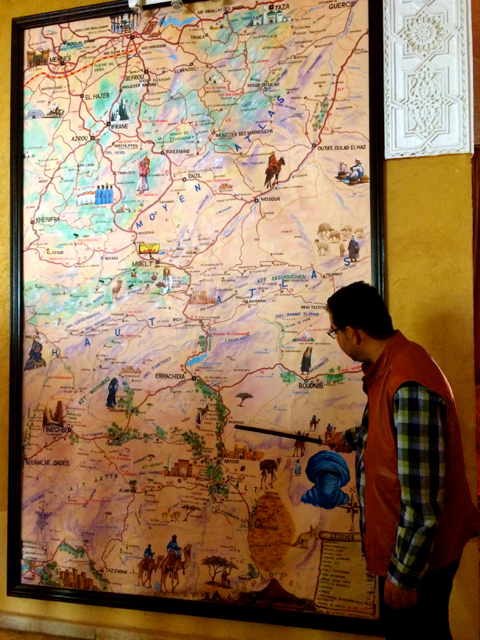 |
| Russ wearing a fez |
A Day in Fez, Morocco, Tour Day 6, WTRD 46 Sep 24, 2016
After our breakfast, we visited the outside of the Royal palace where we were only allowed to photo the front doors (seven of them).Other photos of the walls were forbidden, then we began our guided tour of the medina, one of the world's largest walled cities in Africa.
 |
| Seven Rings expanding outward |
 |
| Ali explains angles in Araabic Numbers |
 |
| Add caption |
We explored the old Jewish quarter
and the narrow streets of the Medina lined with fresh fruit,
mounds of spices, intricately woven Berber carpets, silver teapots, leather slippers, copper pots, knives, and many other art objects of Morocco. One of the funnier moments i snapped was in the meat market where camel meat was being sold. The butcher/merchant moved behind the camel head and I got this image. It's pretty funny. What do you get when you cross a man with a camel?
 |
| A manacamel |
 |
| Narrow streets and alley ways |
We shared these streets with people, stray cats and kittens, and donkeys carrying loads so wide that we would have to step in a threshold or be squashed.
The streets here, because of the donkeys and cats, are dirty and merchants are continually trying to clean the muck in front of their stores making for a sloppy mess to walk through, often slippery.
There is an unpleasant smell that increased 10 fold when we neared the tanneries where dead animals are skinned, fat rendered, and hides tanned.
When we walked into one large tannery, we were given Moroccan "gas masks", large sprigs of fresh mint, to bring up to our noses or crush between our fingers to disguise the sickening odor.
 |
| Fresh mint is used for more than tea. |
We climbed to a terrace above the tannery where animal hides were being processed.
We looked down on numerous vats where men in the blazing sun were either on the side of the vats or in the vats processing, washing, dyeing, drying, and finishing the tanning process. For me it looked like a sentence in hell.
They are paid by piece work and earn 100 to 500 Durham, 10 to 50 USD a day. This is considered a fair wage for very unpleasant physical work. It is a good advertisement for children to go to school and get a good education.
But as our guide said, we cannot all be masters. Some still have to drive the donkey, and people are happy to have jobs with the high unemployment rate. We stopped in a traditional restaurant for lunch, but we were not too hungry after the tannery and were saving ourselves for dinner and entertainment at a local restaurant this evening.
After lunch we still had more exploring to do. We visited a pre-school that Ali had attended as a child. It was a Koranic school then, now a pre-school.
visiting a carpet co-op,
visiting a weaver,
 |
| Add caption |
 |
| Might be a bit large? |
and a pottery and mosaic business.
By 4:00 we were hot, sweaty, and exhausted. We returned to our hotel for a few hours rest before venturing out again for dinner.
Our dinner started with soup, followed by grilled meat, and a sweet chick
en pastil,
fresh fruit, mint tea, and cookies. During dinner, a quartet of men with a tamborine, drum, violin, and mandolin played traditional music. After dinner we were entertained my some male dancers with pots that spun and and were slapped as they twirled and danced, a magician, and two belly dancers.
It was an enjoyable evening, and I would have enjoyed it more if I hadn't been so exhausted from the long and interesting day of cultural explorations.











































































